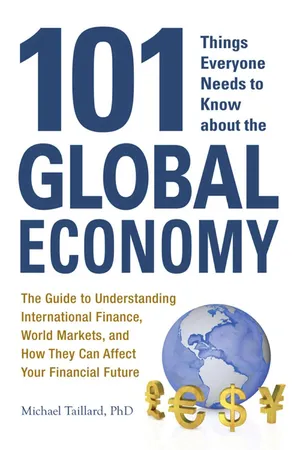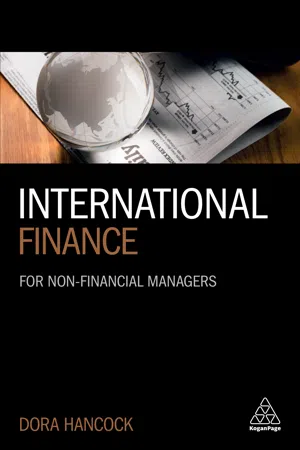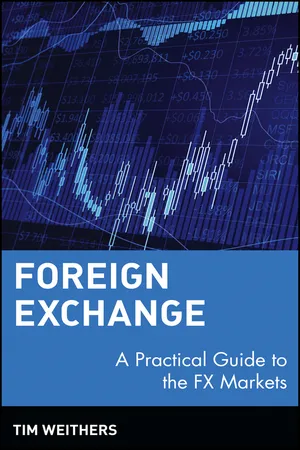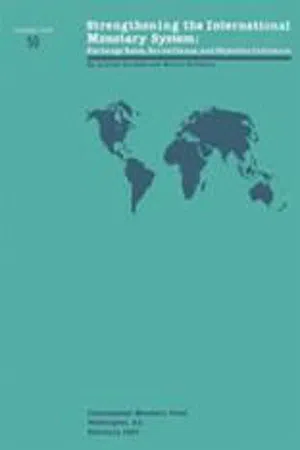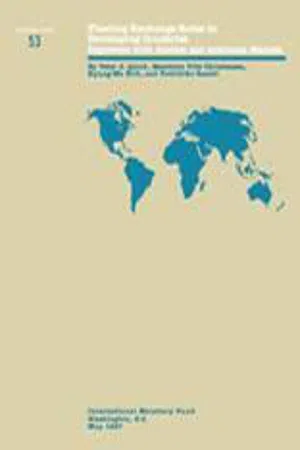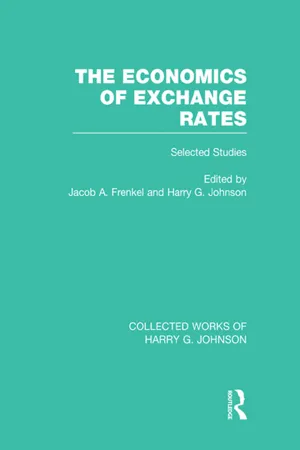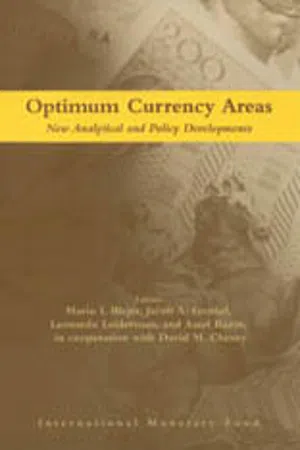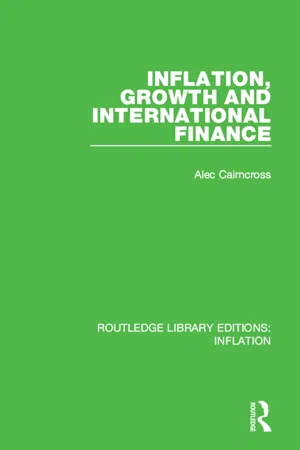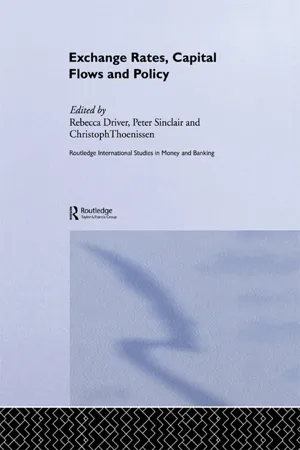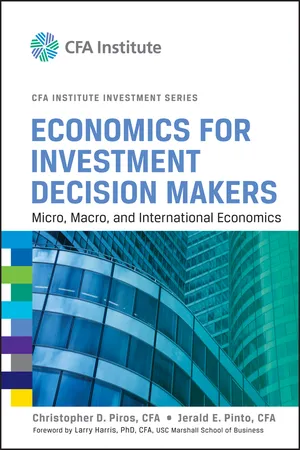Economics
Floating Exchange Rate
A floating exchange rate refers to a currency system where the value of a country's currency is determined by the foreign exchange market based on supply and demand. In this system, the exchange rate fluctuates freely, without government intervention. This allows the currency's value to adjust according to market forces, potentially leading to greater economic stability and flexibility.
Written by Perlego with AI-assistance
Related key terms
10 Key excerpts on "Floating Exchange Rate"
- eBook - ePub
101 Things Everyone Needs to Know about the Global Economy
The Guide to Understanding International Finance, World Markets, and How They Can Affect Your Financial Future
- Michael Taillard(Author)
- 2012(Publication Date)
- Adams Media(Publisher)
The primary determinant of the value of a nation’s floating currency is the value of that nation’s underlying production. The total value of a nation’s economy, as measured by the value of its production (usually using GDP, discussed in Chapter 10), is represented by the nation’s money, and if that number changes, the value of a floating currency in the foreign exchange market also changes. As people invest in that nation’s economy by trading their own national resources for a share of the nation’s currency, they are investing in that nation’s future production potential under the belief that the nation will produce enough to give the currency value as a form of exchange for more goods and services at a later date.There are a great number of other factors involved in determining Floating Exchange Rates. To summarize, you’re watching for any economic changes that will influence the amount of currency that the people of a particular nation might want. You can expect anything that would increase exports to some nation to have an influence on decreasing the exchange rate for that nation’s currency as your own currency increases in value.Why You Should Care
Most of the world’s economically largest nations use floating currencies, and the majority of currencies in the world that are considered to be reserve currencies (those currencies that are held on reserve in large quantities by foreign nations for use as a very commonly accepted or demanded currency for global use) are floating currencies. If you’ve ever engaged in any sort of international trade, there is a strong likelihood that you’ve done trade with a nation that maintains a Floating Exchange Rate.As noted, exchange rates among floating currencies normally vary only to a very small degree at any given point in time, typically measured to hundredths of a percent, called pips (percentage in points). That’s not to say that the rate changes are too small to influence individuals, however. If a company experiences a cost increase associated with higher exchange rates, that cost increase will often translate into higher prices for people purchasing its products. The reverse can be said for lower exchange rates, though. It pays to watch floating rates carefully and see how changes are reflected in consumer prices. - eBook - ePub
International Finance
For Non-Financial Managers
- Dora Hancock(Author)
- 2018(Publication Date)
- Kogan Page(Publisher)
Governments may simply wish to reduce the high levels of volatility often seen in a pure floating rate system. These high levels of volatility create uncertainty and can have an adverse impact on the economy and on international trade. A sudden appreciation might disrupt the export market and a sudden depreciation might increase the rate of inflation. A second reason is to address irrational or short-term fluctuations in exchange rates which might be difficult for those trading internationally and which will not have a long-term effect. In practice, it isn’t easy to distinguish between irrational fluctuations and a fundamental adjustment.Sometimes governments operate a floating rate system publicly but privately are committed to fixed value against another currency or basket of currencies. From 1987 until the UK joined the Exchange Rate Mechanism, the Chancellor of the Exchequer, Nigel Lawson, unofficially pegged the value of the pound against the German mark. This tended to lead to the pound being overvalued compared to the mark and also led to the pound entering the ERM at an unrealistically high rate. Exporting nations tend to be very wary of seeing their currency appreciate against their trading partners because of the impact on the competitiveness of their industries.At its simplest, a Floating Exchange Rate is set by economic principles of supply and demand in the foreign exchange market. If demand for a currency goes up then other things being equal we would expect to see the currency appreciate in value. Equally, if the supply of a currency goes up, through a government printing money for example, then we would expect to see the currency fall in value or depreciate.Now we’ve considered the characteristics of the major exchange rate systems we can turn our attention to their relative merits and investigate the reasons for some countries choosing fixed rate arrangements while others opt for floating rate systems.Advantages and disadvantages of floating rate exchange rate systems
In a floating rate system the government, or its agents, do not have to decide what the exchange rate should be. In theory, floating rate systems have a very effective self-correcting system.Passage contains an image
ExampleSuppose there are only two countries in the world, North and South, who trade with each other. Suppose North wants to buy wheat from South at a cost of $1,000 Southern dollars and South wants to buy oats from North at a cost of £1,000 Northern pounds. If the current exchange rate is $1:£1 then each country will have the foreign currency they need to buy the goods they want from the other country. - eBook - ePub
Foreign Exchange
A Practical Guide to the FX Markets
- Tim Weithers(Author)
- 2011(Publication Date)
- Wiley(Publisher)
Banks, whether commercial, investment, central, or supranational, are intimately involved in the markets for foreign exchange. Commercial banks are sometimes asked to assist their local clients with their foreign exchange risk. Investment banks tend to be more active, but this depends on the reason for their FX trading (facilitating client transactions, hedging their business exposures, cross-border issuance, international mergers and acquisitions, and even proprietary trading). Central bank activity ranges from the management of their foreign reserves through active FX market intervention.Of course, if exchange rates never moved (i.e., if they were fixed), then much of the trading activity (whether hedging or implementing views on the market) would cease. Having spelled out the economic rationale for many of the trades undertaken by the FX market participants, we now consider the possible implications of fixed exchange rates.FIXED VERSUS Floating Exchange RateS
Economists have long debated the advantages, disadvantages, virtues, shortcomings, merits, costs, and benefits of a fixed exchange rate system versus a Floating Exchange Rate system. “Does the choice of exchange rate regime matter? Few questions in international economics have sparked as much debate and yielded as little consensus.”6Fixed Exchange Rates
The attraction of fixed exchange rates is the presumed stability they provide for those engaging in international transactions. If USD|JPY is fixed at 120.00, then a U.S. software firm can enter into trade agreements in which their product will sell for JPY 6,000 in Japan—comfortable that they will receive USD 50 as a result of that sale. Similarly, a Japanese automobile manufacturer might sleep better knowing that their cars, selling in the United States for USD 20,000, will appear on the bottom line as JPY 2,400,000.Sounds good.The real problem, though, with fixed exchange rates is that someone must keep them fixed. If the institutions charged with maintaining the exchange rate (which, if it indeed requires active support, is obviously not set at the market clearing rate) are either unable or unwilling to maintain the peg, then there are potentially large impacts associated with formal devaluation (reduction in a currency’s value) or revaluation (appreciation of a currency’s value). As with agricultural price supports, the minimum wage and rent control, any interference with market prices creates inefficiencies, distortions, and influences behavior in a way that may not be desirable. - eBook - ePub
- Andrew Crockett, and Morris Goldstein(Authors)
- 1987(Publication Date)
- INTERNATIONAL MONETARY FUND(Publisher)
53 They also maintain that the characteristics that make the present system relatively resilient may have other undesirable implications for its performance while it lasts. For example, the great diversity of exchange arrangements may make it more difficult to define “rules of the game” for macroeconomic policies that are sufficiently specific to be effective. Indeed, it is the very lack of such recognized rules of the game, especially for major industrial countries with floating rates that, according to critics, is responsible for the severe misalignments of the floating rate period. Similarly, while they agree that the present system allows the market “to take a view” when centralized decisions are not feasible, they argue that the present system does not offer a sufficient framework for reaching a satisfactory multilateral decision; in addition, the market’s view is too often the “wrong” view. Finally, the same “flex” in exchange rates that provides a defense against “hot money” flows often proves a liability when exchange rates become divorced from fundamentals and get carried along by self-fulfilling destabilizing speculation.Proposals for Improving Exchange Rate Stability
As suggested earlier, both Reports conclude that the functioning of the exchange rate system needs to be improved. Both Reports also agree that perhaps the single most important element in achieving such an improvement lies in the better discipline and coordination of macroeconomic policies in the major industrial countries. The key question then is what mechanisms or channels, including Fund surveillance, are available for reaching that latter objective. Three types of proposals can be identified in the Group of Ten and Group of Twenty-Four Reports as ways of improving exchange rate stability: the adoption of “target zones” for the exchange rates of major currencies; the adoption of “objective indicators” or “targets” for macroeconomic policies in major industrial countries that could be used as a framework for the first stage of multilateral Fund surveillance; and the adoption of policy adjustments and of changes in the procedures for Fund surveillance that could be accomplished within existing exchange rate arrangements and the existing institutional framework for surveillance. - eBook - ePub
- Kyong Huh, Benedicte Christensen, Peter Quirk, and Toshihiko Sasaki(Authors)
- 1987(Publication Date)
- INTERNATIONAL MONETARY FUND(Publisher)
IV Developments Under Floating Exchange Rate Regimes
Most of the developing countries that have adopted Floating Exchange Rates have at the same time pursued supporting monetary and fiscal policies and have liberalized exchange and trade restrictions. Isolating the separate effects of floating is therefore a difficult task. Moreover, because the experience with flexible exchange rates in most of the countries surveyed is recent, inferences that may be drawn must necessarily be regarded as tentative, both because the full effects of flexibility take time to work through an economy and because most of the relevant macroeconomic data are preliminary. These qualifications apply with less force, however, to an examination of the effects of floating on the exchange market itself, that is, on the variables most directly affected by the exchange rate regime. Such an analysis is also helped by the fact that data for exchange rates and certain important exchange market transactions become available with relatively short lags.This section examines the impact of floating and the accompanying adjustment measures, first on the volatility of the exchange rate itself and on capital account transactions, and second in a broader macroeconomic context. Seven of the countries with floating systems (Bolivia, the Dominican Republic, Jamaica, the Philippines, Uganda, Uruguay, and Zaïre) have sufficient experience with floating for at least some of these questions to be addressed. For each of these countries, the volatility of the exchange rate, vis-à-vis the U.S. dollar and in nominal and real effective terms, is compared between the pre-floating and post-floating periods. Capital account transactions are examined using the available data from the balance of payments, cross-border bank deposits, external debt, and the parallel exchange market. Pre-float and post-float developments in inflation and in output and trade are also analyzed in this section. - eBook - ePub
- Jacob Frenkel, Harry Johnson(Authors)
- 2013(Publication Date)
- Routledge(Publisher)
CHAPTER 3THE EXCHANGE RATE, THE BALANCE OF PAYMENTS, AND MONETARY AND FISCAL POLICY UNDER A REGIME OF CONTROLLED FLOATING MICHAEL MUSSAUniversity of Chicago, Chicago, Illinois, USAABSTRACTThis paper considers the extension of the fundamental principles of the monetary approach to balance of payments analysis to a regime of Floating Exchange Rates, with active intervention by the authorities to control rate movements. It makes four main points. First, the exchange rate is the relative price of different national monies, rather than national outputs, and is determined primarily by the demands and supplies of stocks of different national monies. Second, exchange rates are strongly influenced by asset holders’ expectations of future exchange rates and these expectations are influenced by beliefs concerning the future course of monetary policy. Third, “real” factors, as well as monetary factors, are important in determining the behavior of exchange rates. Fourth, the problems of policy conflict which exist under a system of fixed rates are reduced, but not eliminated, under a regime of controlled floating. A brief appendix develops some of the implications of “rational expectations” for the theory of exchange rates.INTRODUCTIONThe current system of controlled floating differs significantly from the exchange rate system which existed prior to 1971 and from textbook descriptions of freely flexible rates. Governments no longer seek to maintain fixed parities; neither do they forego direct intervention in the foreign exchange markets. Nevertheless, it is the central contention of this paper that the basic theoretical framework of the monetary approach to the balance of payments, developed for a fixed rate system, remains applicable. This approach emphasizes that both the balance of payments (meaning the official settlements balance) and the exchange rate are essentially monetary phenomena.1 - eBook - ePub
- Leonardo Leiderman(Author)
- 1997(Publication Date)
- INTERNATIONAL MONETARY FUND(Publisher)
When a decision must be made on the adoption of an exchange rate regime, as Jacob Frenkel has stressed, the focus must be placed where it belongs, that is, on whether the regime will foster good or bad economic policies. From this standpoint, what the concept of currency areas added to the debate of fixed versus Floating Exchange Rates is the idea that an optimum currency domain has really little to do with national frontiers. In his seminal article on the subject, Mundell explored the question of whether all national currencies should float. In other words, whether nations should take it for granted that flexible exchange rates represented an appropriate regime for each and all of them.Experience on this front seems to conform to a cyclical pattern: countries adopt a fixed exchange rate regime; they become disenchanted with the constraints they impose on their national policy autonomy and they move toward flexible exchange rate arrangements; they then balk at the uncertainties created by unfettered national policy discretion and seek to contain them by reverting toward less flexible arrangements.The advantages of fixed exchange rate regimes are of course those of “pooling.” Countries with inappropriate economic policies “export” part of their imbalances, making others share in their costs. Discomfort with such exports grows over time, particularly in those countries with relatively better economic policies—those that “import” the costs of imbalance and export the benefits of balance—and pressure builds up for insulation and, hence, for floating. In this manner, international exchange arrangements tend to move from rules to discretion, reflecting shifts in the balance of national and international interests, to which I referred earlier.The problem with discretion-based international regimes, of course, is that they make it harder to assign unambiguously responsibilities for policy adjustments. In situations of imbalance, should primary responsibility for policy correction fall upon deficit or surplus countries? The practical counterpart of this assignment dilemma is to identify the inappropriateness of policies and the consequent need for weighing a variety of policy indicators, not all of which point in the same direction or are of the same importance. In this context, the merits of the simplicity of a fixed exchange rate are clear: domestic policies should be compatible with the external constraint or be appropriately adjusted. It is, in essence, a single indicator system. - eBook - ePub
- Alec Cairncross(Author)
- 2016(Publication Date)
- Routledge(Publisher)
system can we hope for? A world of fixed rates in which one country elects to float is very different from a world of floating rates in which no country can by itself achieve fixity. In the latter kind of world, economic warfare would tend to spread from one area of policy to another unless governments came to some understanding about the key exchange rates and reintroduced some degree of fixity in them.It is, of course, true that some of the big industrialised countries have acted first and argued after. No doubt this will continue. It is also true that what has put most pressure on exchange rates has been a serious loss of reserves or an inordinate increase in them. That, too, may well continue. Finally, it is true that the industrialised countries as a group seem inclined to take a more experimental line on exchange rate management. This may mean that they yield more promptly to strong and continuing pressure on their reserves; but they are unlikely to do so automatically and invariably, and for reasons already given above, it would be wrong for them to surrender all discretion and treat market pressure as the fount of wisdom.The conclusion to which all this leads is not that exchange rates should stay fixed or be changed only at long intervals or by large amounts. It is that the rate should normally be held stable within declared limits around a stated par value; that a decision to change the rate is necessarily an act of judgement forming an indispensable part of economic management; and that such a decision must balance opposing considerations. To hold the rate constant in face of evidence of actual or impending international disequilibrium may put too much faith in the power of economic and administrative measures to effect a gradual restoration of equilibrium. On the other hand, to let the rate change too easily and frequently has important disadvantages. It lets loose economic forces that may eventually work in the right direction but in the short run are liable to work in the wrong direction and have large and incalculable effects on the behaviour of the economy as a whole. - eBook - ePub
- Rebecca Driver, Peter J N Sinclair, Christoph Thoenissen(Authors)
- 2013(Publication Date)
- Routledge(Publisher)
4The expenditure switching effect and the choice between fixed and Floating Exchange Rates*Ozge Senay and Alan Sutherland1 Introduction
This chapter analyses the macroeconomic implications of fixed and Floating Exchange Rate regimes and presents a welfare comparison of the two regimes in the presence of stochastic foreign monetary shocks. The main focus of analysis is the role played by the expenditure switching effect of exchange rate changes in the choice of exchange rate regime.Early proponents of Floating Exchange Rates, such as Friedman (1953), argued that Floating Exchange Rates are desirable because they provide a degree of insulation against foreign shocks. A floating rate regime allows a country to set monetary policy independently from monetary policy in other countries. This prevents the transmission of foreign monetary policy shocks to the domestic economy. Furthermore, when goods prices are sticky, a floating rate regime allows relative prices to adjust in response to country specific real demand and supply shocks. Thus, it was argued, Floating Exchange Rates act as a ‘shock absorber’ which helps stabilise the domestic economy in the face of both monetary and real shocks.Recently there has been a growing literature on the choice of exchange rate regimes based on welfare comparisons in general equilibrium models with sticky-prices. This new literature has allowed a re-examination of the shock-absorber role of the exchange rate. A particularly important issue that has emerged in the recent literature (see Devereux and Engel (1998, 2003), Devereux (2000) and Bachetta and van Wincoop (2000)) is the distinction between ‘producer currency pricing’ (where prices are fixed in the currency of the producer) and ‘local currency pricing’ (where prices are fixed in the currency of the consumer). One implication of local currency pricing is that the expenditure switching effect of exchange rate changes is much reduced (or even eliminated). This tends to reduce the ability of the exchange rate to act as a shock absorber in response to real demand and supply shocks and thus alters the welfare case for Floating Exchange Rates. - eBook - ePub
Economics for Investment Decision Makers
Micro, Macro, and International Economics
- Christopher D. Piros, Jerald E. Pinto(Authors)
- 2013(Publication Date)
- Wiley(Publisher)
14 The hope was that the common currency would increase transparency of prices across borders in Europe, enhance market competition, and facilitate more efficient allocation of resources. The drawback, of course, is that each member country lost the ability to manage its exchange rate and therefore to engage in independent monetary policy.4.3. A Taxonomy of Currency Regimes
Although the pros and cons of fixed and flexible exchange rate regimes continue to be debated, many countries adopt regimes that lie somewhere between these polar cases. Countries adopt specific regimes for a variety of reasons. In some cases, the driving force is the lack of credibility with respect to sound monetary policy. A country with a history of hyperinflation may be forced to adopt a form of fixed-rate regime because its promise to maintain a sound currency with a floating rate regime would not be credible. This has been a persistent issue in Latin America. In other cases, the driving force is as much political as economic. The decision to create the euro was strongly influenced by the desire to enhance political union within the European Community, whose members had been at war with each other twice in the twentieth century.As of April 2008, the International Monetary Fund (IMF) classified the actual (as opposed to officially stated) exchange rate regimes of its members into the eight categories shown in Exhibit 9-8 .It should be noted that global financial markets are too complex and diverse to be fully captured by this (or any other) classification system. A government’s control over the domestic currency’s exchange rate will depend on many factors—for example, the degree of capital controls used to prevent the free flow of funds in and out of the country. Also, even those countries classified as using an independent float regime will occasionally intervene in foreign exchange markets in order to influence the value of their domestic currency. Additionally, the specifics of exchange rate policy implementation are subject to change. (For example, the Chinese yuan was officially pegged against a basket of currencies prior to the 2008 crisis in the global financial market, but the Chinese government switched back toward focusing on the rate against the U.S. dollar after market volatility rose.)
Index pages curate the most relevant extracts from our library of academic textbooks. They’ve been created using an in-house natural language model (NLM), each adding context and meaning to key research topics.
